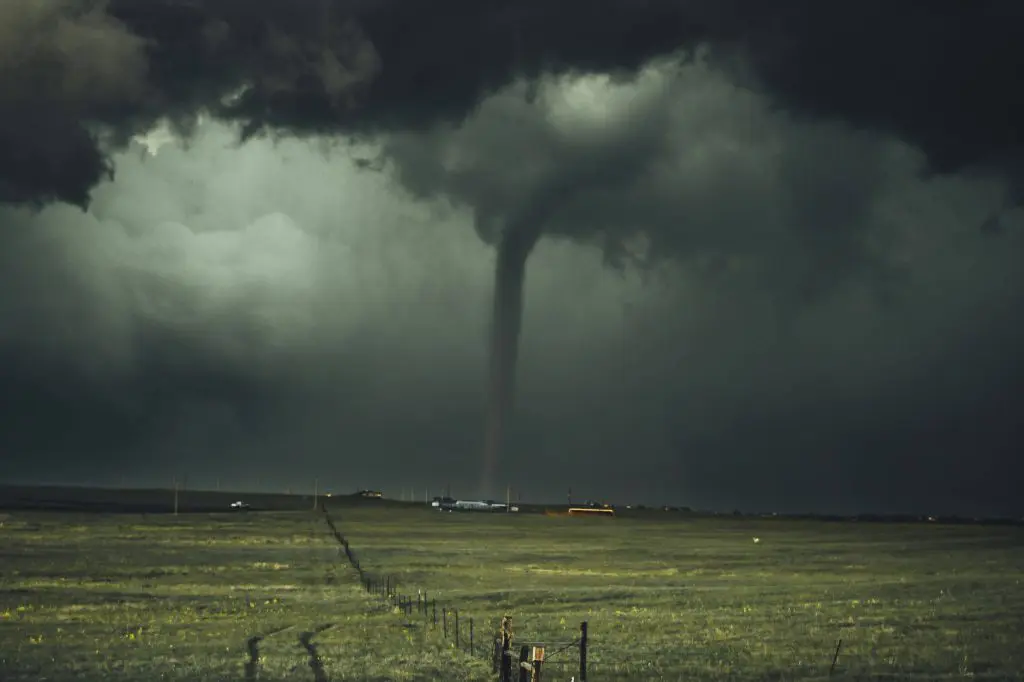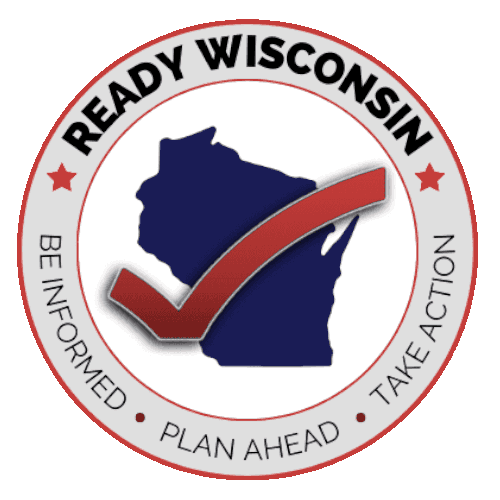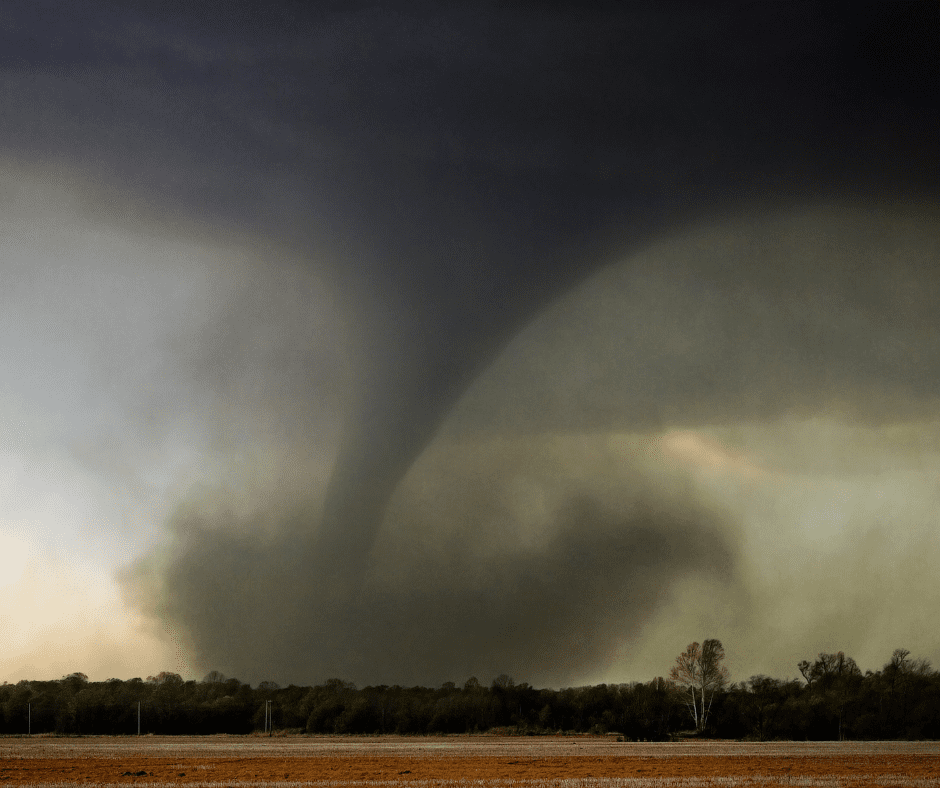A tornado is a rotating column of air that extends from a thunderstorm to the ground. They can cause fatalities and devastate communities in a matter of seconds. Not all tornadoes may be visible at first, and they could occur at any time of day or night. Planning and practicing how and where you take shelter could save your life.
Wisconsin averages 23 tornadoes a year. Peak tornado season in Wisconsin is April to August, but they can occur any time of year.
Next statewide tornado drill will be on Thursday, April 16, 2026 @ 1:45 p.m. and 6:45 p.m. At those times we encourage everyone to discuss and practice their tornado safety plans.
The statewide tornado drill occurs annually during Wisconsin Tornado and Severe Weather Awareness Week.
Terms Used During a Tornado
Tornado Watch
Tornadoes are possible. Watch the sky and stay tuned to a NOAA Weather Radio, commercial radio, or television for information. Watch for alerts on your smartphone and check social media for information from trusted sources.
Tornado Warning
A tornado has been spotted or indicated by weather radar. Take shelter immediately. A warning can cover parts of counties or several counties in the path of danger.
Tornado Danger Signs
Warning signs may include the following:
- A change in the color of the sky
- Wall cloud. This is an isolated lowering of the base of the thunderstorm
- Swirling debris on the ground or debris rising up in the air
- Large hail
- Funnel-shaped cloud extending from a thunderstorm
- Roaring noise, similar to a freight train

Protecting Yourself…
…Before a Tornado
- Be weather-ready. Check out your forecast regularly to see if you’re at risk for tornadoes. Listen to a NOAA Weather Radio or local news for the latest information. Look for approaching storms and keep an eye on weather conditions.
- Be notified. Know how you will be warned if a tornado is in your area. Some communities have outdoor tornado sirens, but they cannot always be heard indoors. Make sure your smartphone is enabled to receive wireless emergency alerts. Download a local news app that will send weather push notifications to your smartphone. Stay tuned to local news on social media and have a NOAA Weather Radio to receive alerts.
- Know your safe spot Pick a safe room in your home, such as a basement, storm cellar, or an interior room on the lowest floor with no windows. If you live in a mobile home or home without a basement, identify a nearby safe building you can get to quickly such as a community storm shelter, church, or family member’s home. Don’t forget your pets.
- Practice. Have periodic tornado drills so everyone knows what to do if a tornado is approaching. Don’t forget your pets.
- Do a household inventory. Take photos and videos of all major household items and valuables. Retain these in a safe place because they are important when filing insurance claims.
- Secure Objects. Move or secure lawn furniture, trash cans, hanging plants, or any other objects that can be picked up by the wind and become a projectile. Remove damaged or diseased limbs from trees.
…During a Tornado
- Pay attention to alerts. Stay updated on any developing emergency information from EAS, NOAA Weather Radio, or local alerting systems.
- Stay in shelter until the storm has passed.
- Tips for when you are…
- At home:
- Take shelter immediately. The safest spot to be is in a safe room, storm cellar, or basement. Cover your head with your arms, a mattress, or heavy blanket.
- If a storm cellar or basement is not available – Find a small, windowless interior room or hallway on the lowest level of a sturdy building. Stay away from windows and large auditoriums or warehouses.
- In a mobile home:
- Make a plan of action during your blue-sky days, well ahead of any storm threats.
- Pick a substantial shelter nearby that allows you 24-hour access
- Know how long it takes to get there
- Understand you may end up evacuating for “no reason.” Waiting until the storm is certain to hit your area may be too late.
- Evacuate when notified. If a tornado watch is issued in your community and storms are headed toward your area, it is time to evacuate your home to a studier shelter. Waiting until a warning may be too late
- Take important documents with you and don’t forget your pets.
- Keep listening to local news or NOAA Weather Radio for more updates impacting your area.
- Let your family and close friends know where you are evacuating to. Ask if family and close friends in vulnerable housing need to relocate as well.
- As a Last Resort: If a Tornado Warning is issued for your community before you evacuate, it may already be too dangerous to evacuate to a safer location. Last resort options include a vehicle (seatbelt on and start car to activate airbags/safety features) or in a protected area outside shielded from potential debris or flooding.
- Make a plan of action during your blue-sky days, well ahead of any storm threats.
- In a vehicle:
- Drive safely and get to the nearest sturdy shelter.
- Never drive towards a tornado or in the vicinity of a tornado. Tornadoes can change direction or speed quickly. Drive at right angles away from the tornado.
- If flying debris occurs while driving, pull over and park. Do not try to outrun a tornado.
- Stay in the car with the seat belt on. Put your head down below the windows; cover your head with your hands and a blanket, coat or other cushion if possible.
- Outdoors:
- Find shelter in a sturdy building immediately if a tornado is approaching. Sheds and storage facilities are not safe. Neither is a mobile home or tent.
- If shelter is not available or there is no time to get indoors, lie in a ditch or low-lying area and cover your head with your arms.
- NEVER take shelter under a bridge or an overpass. The wind funnels debris under these structures, making these debris into weapons that could strike anyone hiding underneath. You are much safer in a ditch or low, flat location.
- Watch out for flying debris. Flying debris from tornadoes cause the most fatalities and injuries.
- At home:
…After a Tornado
- Be informed. Continue listening to a NOAA weather radio or local news for updated information. Cooperate fully with public safety officials.
- If you are trapped. Attract attention to yourself. Send a text, bang on a wall or pipe, or use a whistle to help rescuers find you.
- Check for injuries. Do not attempt to move seriously injured people unless they are in immediate danger. Get medical assistance immediately.
- Stay out of damaged buildings. Be aware of hazards such as exposed nails and broken glass.
- Check utilities. Check gas, electrical, and water lines for damage. If you smell gas or see a broken line, shut off the main valve from outside. If you see frayed wiring or sparks, immediately shut off the electrical system at the main circuit breaker. Watch out for fallen power lines or broken gas lines. Report them to the utility provider immediately.
- Take Pictures. Take pictures of your property and buildings as well as contents inside the building. This will help you with insurance claims.
- Hearing strange house noises? Leave your home or building if you hear shifting or unusual noises. Those sounds could mean the building is about to collapse.
- Be safe during cleanup. Wear the appropriate gear such as thick-soled shoes, long pants and work gloves. Use appropriate face coverings or masks if cleaning mold or other debris.
- Check in with neighbors. If you are safe, make sure those around you are not in danger or if they need help. It can take time for first responders to reach a disaster site, and you may be the help until they arrive.
- Use caution when hiring contractors to repair storm damage.

